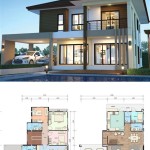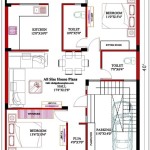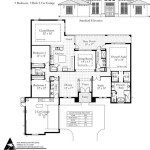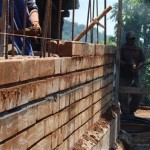Shallow House Plans: A Comprehensive Guide
Shallow house plans, characterized by their relatively narrow footprint and often elongated shape, are gaining popularity for their ability to maximize space on smaller or oddly-shaped properties. These designs offer a practical and attractive alternative to traditional, deeper homes, particularly in urban or suburban areas where land is limited. This article will delve into the benefits, considerations, and key features of shallow house plans, providing a comprehensive guide for those looking to build or renovate their homes.
Advantages of Shallow House Plans
Shallow house plans offer a unique set of advantages that can significantly benefit homeowners. One of the most prominent benefits is their ability to maximize natural light. The elongated shape allows for larger windows and more exposure to sunlight, creating a brighter and more inviting living space. This is particularly beneficial in areas with limited sunlight or where maximizing natural light is a priority.
Another significant advantage of shallow house plans is their cost-effectiveness. Compared to deeper houses with similar square footage, shallow houses require less material for construction, primarily due to the reduced roof area. This translates to potential cost savings in materials, labor, and energy consumption. Furthermore, shallow plans often require less excavation and foundation work, further contributing to lower construction costs.
Moreover, shallow house plans offer a range of design flexibility. Their elongated shape allows for creative layout options, maximizing space utilization and functionality. For example, a shallow house may be ideal for creating open-plan living spaces, maximizing natural light and creating a sense of flow throughout the home. Additionally, shallow plans can be easily adapted to different lot shapes and sizes, accommodating diverse needs and preferences.
Key Considerations for Shallow House Plans
While shallow house plans offer many advantages, there are also important considerations to keep in mind before choosing this design. One key consideration is maximizing natural light. While shallow plans are typically well-suited for maximizing daylight, it's essential to strategically place windows to ensure adequate light distribution throughout the entire house. For example, consider using skylights to bring light into internal spaces and strategically positioning windows to create cross-ventilation for optimal airflow.
Another important consideration is optimizing the layout of the house. Since shallow houses tend to be long and narrow, careful planning is required to ensure proper flow and functionality. Consider using open-plan designs to enhance the sense of space and minimize the feeling of confinement. Additionally, strategically placing interior walls and doors can promote a sense of privacy and separation within the home.
Finally, it's crucial to consider the impact of the shallow plan on the aesthetic appeal of the house. While a long and narrow design can be visually interesting, it's important to ensure that the house maintains visual balance and proportion. Consider using landscaping, architectural elements, and exterior paint to create a cohesive and visually appealing exterior design.
Features of Shallow House Plans
Shallow house plans typically feature a variety of elements designed to maximize space and functionality. One common feature is an open-plan layout. This design eliminates interior walls, creating a larger, more spacious and interconnected living area. This is particularly beneficial for small families or those who prioritize social interaction and shared living spaces.
Another common feature is the use of natural light. Shallow houses often incorporate large windows and skylights to maximize natural light penetration. This not only creates a brighter and more inviting atmosphere but also reduces the reliance on artificial lighting, leading to energy savings.
Shallow house plans often feature outdoor living spaces that seamlessly blend indoor and outdoor living. Patios, decks, and walkways are incorporated into the design, creating a sense of flow between the house and the surrounding landscape. These outdoor spaces offer additional living areas, perfect for entertaining or simply enjoying the outdoors.
In conclusion, shallow house plans present a unique and advantageous alternative to traditional housing designs. With their focus on maximizing space, natural light, and cost-effectiveness, these plans are becoming increasingly popular for homeowners looking to make the most of their property. By carefully considering the key considerations and embracing the design features of shallow house plans, homeowners can create a functional, attractive, and sustainable living environment.

3 Bed Farmhouse Ranch For The Wide And Shallow Lot 890085ah Architectural Designs House Plans

4 Bed House Plan For A Shallow Lot 31515gf Architectural Designs Plans

Blueprints House Shallow Lot Buscar Con Google Beach Plans Southwest

Modern House Plan With Drive Under Garage For The Shallow Lot 23817jd Architectural Designs Plans

Blueprints House Shallow Lot Buscar Con Google Beach Plans Southwest

Royaloak Shallow Lot Home House Plans Ranch

House Plans For Narrow Lots And Wide

Jay S Place Shallow Two Story House Plan By Mark Stewart

Modern Plan 1 981 Square Feet 3 Bedrooms 2 5 Bathrooms 8318 00068

Mid Size Country Home Plan For The Wide And Shallow Lot 55219br Architectural Designs House Plans








